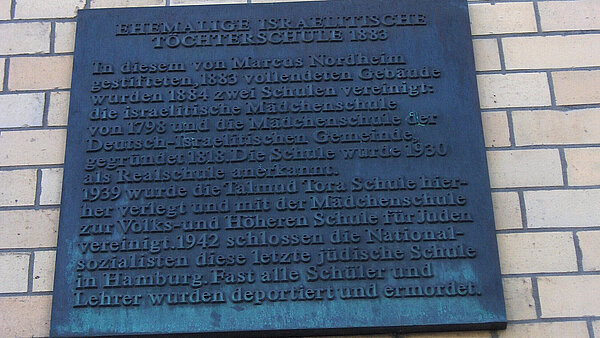Jewish Girls’ School Memorial and Educational Site
The Jewish Girls’ School (Israelitische Töchterschule) was established when two smaller Jewish girls’ schools merged. It opened in a new building near the Holstentor on 20 April 1884. The number of students grew rapidly. A gymnasium opened at the school in 1900, and a teaching kitchen and labs for chemistry and physics classes were added in 1910. Dr Alberto Jonas, who took over from Mary Marcus (1844–1930) as head of the school in 1924, reformed the school based on modern concepts for educating girls. Four years of basic education were followed by four years of primary schooling and six years of secondary schooling.
Jewish Girls’ School under the National Socialists
After the National Socialists came to power in 1933, more and more students left the school and fled abroad with their families. At the same time, new Jewish students came to the school because the Nuremberg Laws prohibited them from attending general public schools. Dr Jonas and his staff tried to shelter the students from discrimination and strengthen their sense of self-worth. On 1 April 1939, the around 600 remaining students were transferred to the Talmud Torah School on Grindelhof to merge with the boys’ school there. But Karl Kaufmann, the Nazi Party Gauleiter (regional leader) for Hamburg, intervened, and a few months later the girls returned to the building on Karolinenstrasse.
Deportations
The school tried to operate normally despite the many air-raid warnings. But deportations began in October 1941, and by December 1941 the school only had 76 pupils. On 15 May 1942, the school had to leave the building on Karolinenstrasse. When all Jewish schools in the German Reich were forced to close on 30 June 1942 and classes for Jewish children were prohibited, most of the remaining 76 children and their teachers were deported. Dr Jonas died in 1942 in the Theresienstadt ghetto. In the last years of the war, the former school building was used by the Gestapo.
Post-war use
After the end of the war, a speech therapy school moved into the building. In 1981, the building was classified as a historic monument and the original inscription that read ‘Israelitische Töchterschule’ was reconstructed. A plaque was placed on the façade in 1984, and at the end of the 1980s the building was transformed into a memorial and educational site operated by the Hamburger Volkshochschule, an adult education institution. This institution now holds events there as part of its political education programme, particularly on Jewish topics. The Jewish Girls’ School Memorial and Educational Site also offers city tours focusing on Jewish history in Hamburg.
The permanent exhibition is located on the top floor. Entitled ‘Jewish Children's Worlds: The History of the Jewish Girls' School,’ it conveys Jewish school life and the lives of children in Hamburg between the German Empire, the Weimar Republic, and persecution under National Socialism up to the present day.
Contact
Gedenk- und Bildungsstätte Israelitische Töchterschule
Opening hours:
Exhibition: Thursday 2pm to 5pm and Sunday 10am to 2pm and after agreement
Guiding tours for school classes and other groups: toechterschule@vhs-hamburg.de
Public guided tours (in german): Dates here



